
views
- Prune lemon trees in early spring, before they flower and new growth starts to appear. Cut off no more than ⅓ of the branches in a single year.
- Trim any vertical-growing sprouts from the base or trunks of the tree and remove dead, diseased, or crossed-over branches.
- As you prune, shape the tree so it’s larger at the bottom. Remove a portion of the fruit to redirect the tree’s energy into growing larger, ripened lemons.
Pruning to Maintain Your Lemon Tree
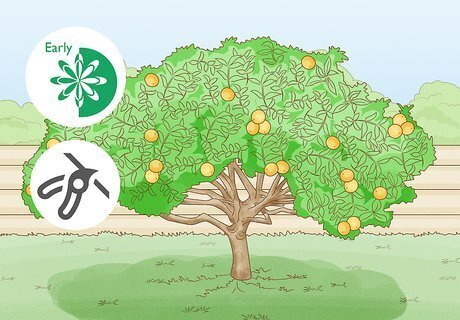
Prune your lemon trees in early spring. Lemon trees don’t lose their leaves or have a true dormancy period. However, their growth and metabolism slow down after the fruit is harvested, just before rapid spring growth. Prune your lemon trees before they flower or spring growth starts to appear. EXPERT TIP Steve Masley Steve Masley Home & Garden Specialist Steve Masley has been designing and maintaining organic vegetable gardens in the San Francisco Bay Area for over 30 years. He is an Organic Gardening Consultant and Founder of Grow-It-Organically, a website that teaches clients and students the ins and outs of organic vegetable gardening. In 2007 and 2008, Steve taught the Local Sustainable Agriculture Field Practicum at Stanford University. Steve Masley Steve Masley Home & Garden Specialist Our Expert Agrees: It's best to prune lemon trees in the early spring before new growth has started. That way, as the growing season starts, the tree will redirect growth into the branches you've kept. If you prune at other times of the year, the plant has already committed resources to the branches you're cutting, so it's more stressful. Also, pruning can often stimulate new growth, so if you prune going into the winter, that new growth is likely to be damaged by a hard frost. Ensure that your cutting tools are sharp and clean before pruning. Lemon trees can often have sharp thorns, so it’s important to wear long sleeves, protective footwear, and eye protection glasses while pruning your lemon trees.
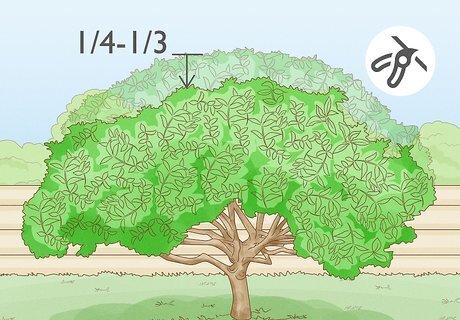
Prune less than ⅓ of the branches in a single year. Only remove up to ¼ to ⅓ of the canopy of the lemon tree. If you prune too much all at once, you could risk stressing the tree, causing the branches to die from the tip of the leaves backward or the entire tree to die completely. Lemon tree bark can damage easily, so avoid slicing the trunk or the surrounding branches while pruning.

Cut any suckers or water sprouts smaller than the diameter of a pencil. Water sprouts are vertical-growing sprouts that appear along the trunk or large branches of the tree. Suckers grow along the roots or at the base of the tree. If water sprouts or suckers aren’t pruned, they can ruin the tree’s shape and divert energy from the lemons and the rest of the tree. Use hand pruners to remove these shoots as soon as they appear. Suckers can reduce fruit yield and adversely affect the health of the lemon tree. They often surpass the height of the main plant in a couple of months if left unchecked, "sucking" the nutrients from the bearing part of the tree.
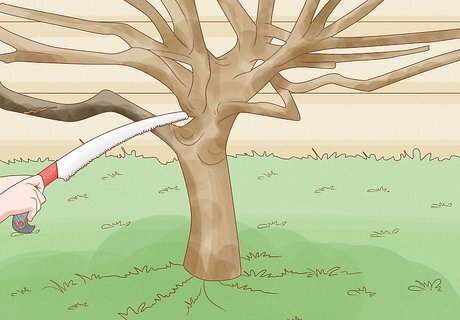
Prune any branches that are damaged or diseased. Any growth that has frost damage, appears discolored, or has been eaten away by insects should be removed right away. Trim at a slight angle near the main trunk of the tree using loppers or a handsaw to remove larger branches. Continue to trim back damaged or diseased branches when they appear throughout the year. Use a pole saw to remove branches that are too high to reach with loppers or a handsaw.
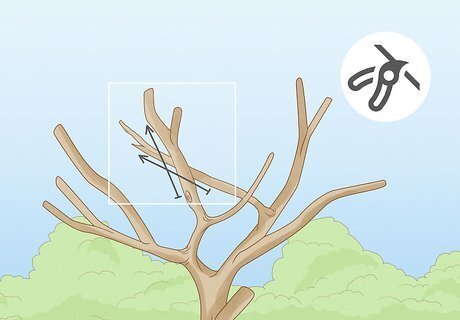
Remove larger branches that cross over each other. On mature trees, crisscrossed branches should be removed to allow more light into the canopy. When cutting branches that are over 1 ½ in (3.8 cm) in diameter, use a handsaw to saw through about a third of the branch from the underside. Make another cut a couple of inches (centimeters) further out, connecting with the first cut. This method prevents bark from stripping from the trunk. If too many large branches are pruned at once, more suckers or water sprouts may form. Cut bigger branches sparingly, only if they’re detrimental to the health of the tree or the fruit.
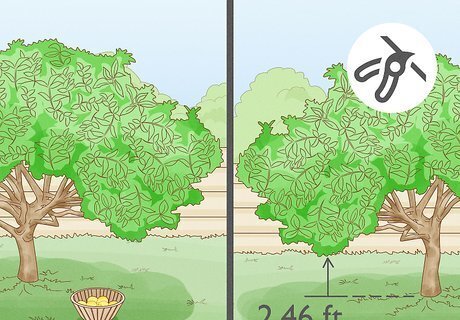
After harvest, remove any downward-pointing branches. Cutting off the branches and limbs that hang down to the ground can give your trees better air flow, reduce insect access to the tree, and allow you to harvest fruit more easily. Remove the lower branches on mature trees to at least 2.46ft (75cm) above the ground. Pruning downward growing shoots while the trees are young can help redirect the tree’s growth upwards, which can help shape the tree for greater future fruit production.
Creating a Healthy Frame
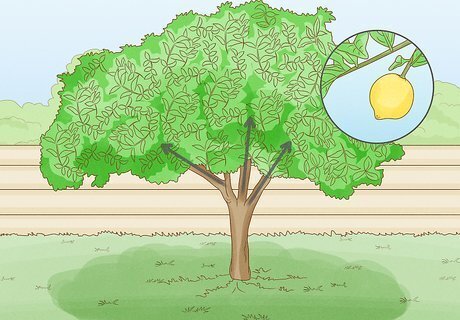
On newly planted trees, pick about eight scaffold branches to keep. These large, dominant branches should be staggered around the tree so that the branches won’t overcrowd each other or weaken as the tree continues to develop. Choose and maintain the horizontal shoots growing off of the scaffold branches so they’ll grow into branches where fruit will grow. Prune the other shoots. Remove a large scaffold branch from a different section of the tree every two to three years to increase light exposure at the center of the tree.
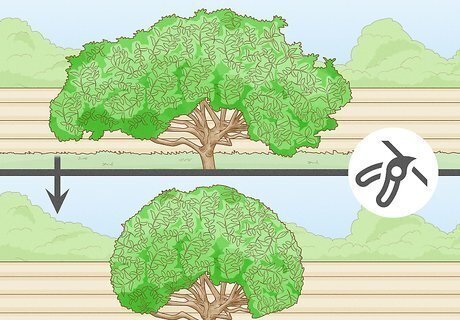
As you thin the canopy, aim to create a crown-shaped frame. A crown-shaped frame makes the tree bigger at the bottom than at the top, allowing for equal sunlight to all parts of the tree. Lemons need sunlight to mature and develop—if the tree’s canopy becomes too thick or dark, divide the tree into quarters and prune one section at a time, removing the higher sprouts and branches to expose the lower ones to the sunlight. Try not to take off a lot of large branches that open up the middle of the canopy to direct sunlight, which can cause sunburn damage to the other branches.
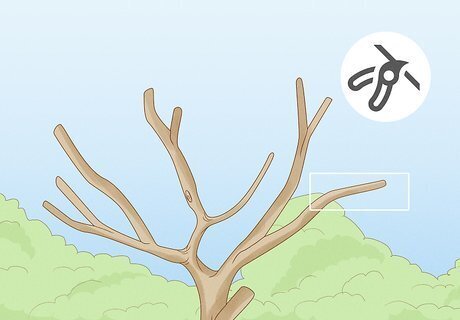
Pinch off the tips of water sprouts growing from the ends of the main branches. This can force the shoots to become thicker and sturdier branches. Encourage more bushy growth by thinning out overcrowded branches as they grow. If your lemon tree is newly planted, over the next several growing seasons concentrate on pruning the main branches and allow secondary branches to grow out from them. If your lemon tree has been overwintered or looks severely unhealthy, you can cut the plant back by about ½ to renew the plant and help it to grow healthy shoots.
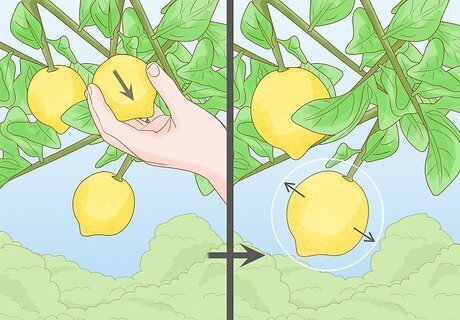
Prune a portion of the tree’s fruit to put energy into growing larger lemons. Citrus trees tend to produce more fruit than they can keep up with, so it can be best to reduce the number of lemons growing so that the tree puts all of its energy into making sure the remaining lemons grow larger and ripen properly. In general, lemon trees that are around 3ft (1m) tall should only grow around 20 fruits at a time. Trim off the remaining fruits or flowers. If your tree is a year old or younger, prune any flowers or small fruit. This way, the tree puts its energy into building new roots and branches instead of into flowers and small less-tasty fruits.

















Comments
0 comment